Top 5 Bedroom Plants for Health and Wellness According to Science
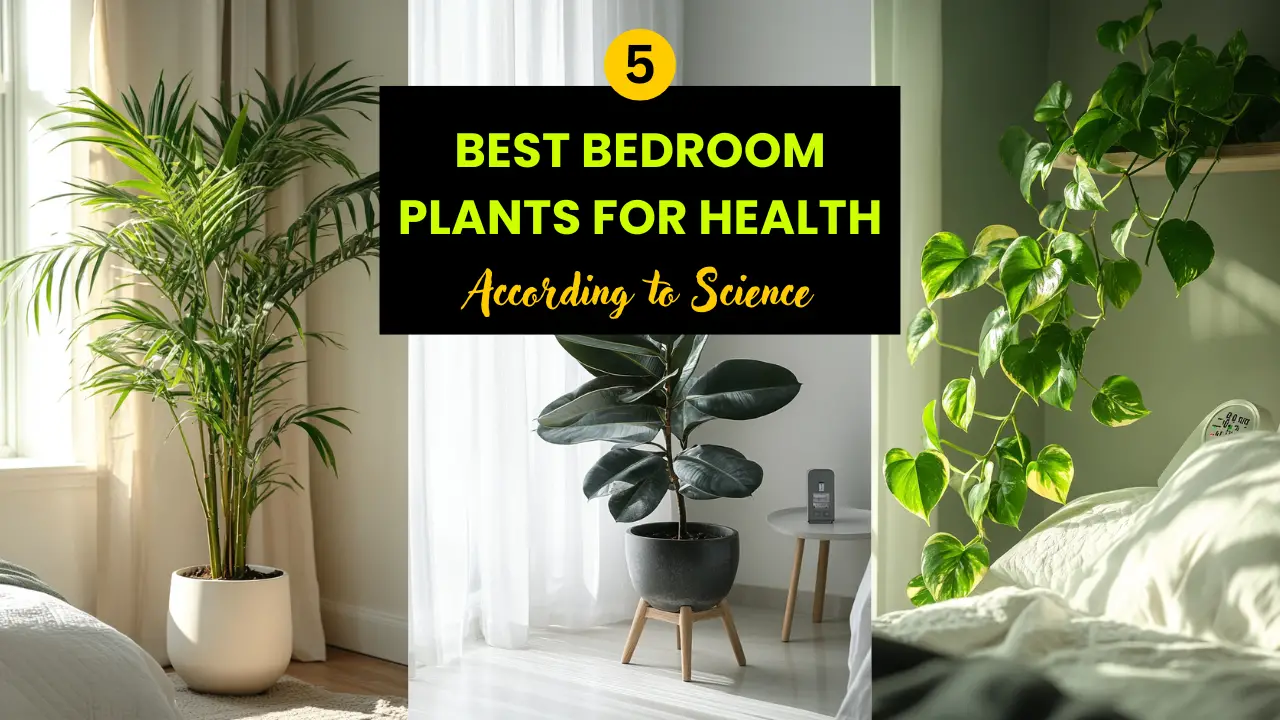
Indoor air quality plays a crucial role in our overall health and well-being.
Many people don’t realize that the air inside their homes can be more polluted than outdoor air.
Plants act as nature’s air purifiers, removing toxins and improving indoor air quality.
They absorb harmful chemicals through their leaves and roots, breaking them into harmless byproducts.
Beyond air purification, plants offer additional health benefits.
They increase humidity, reduce stress, and enhance mood.
Some even promote better sleep, making them perfect for the bedroom.
In this post, I’ll reveal the top five bedroom plants for health and wellness.
By the end, you’ll have a clear understanding of how to transform your bedroom into a healthier, more rejuvenating space.
Plant 1: Boston Fern
The Boston Fern stands out as a top choice for bedroom air purification.
Its lush, green fronds not only add a touch of nature but also work tirelessly to clean the air you breathe.
Air purifying capabilities:
Boston Ferns excel at removing formaldehyde from the air.
They also filter out xylene and toluene, common indoor pollutants.
These plants act as natural humidifiers, increasing moisture in the air.
Health benefits:
The increased humidity from Boston Ferns can alleviate respiratory issues.
They help reduce dry skin and prevent static electricity buildup.
Boston Ferns may lower stress levels and promote a sense of calm in your bedroom.
Care instructions and ideal bedroom placement:
Boston Ferns thrive in indirect light, making them perfect for bedroom corners.
They prefer consistently moist soil but not waterlogged conditions.
Mist the fronds regularly to maintain humidity.
Place your Boston Fern on a plant stand or hang it in a basket near a north-facing window for optimal growth.
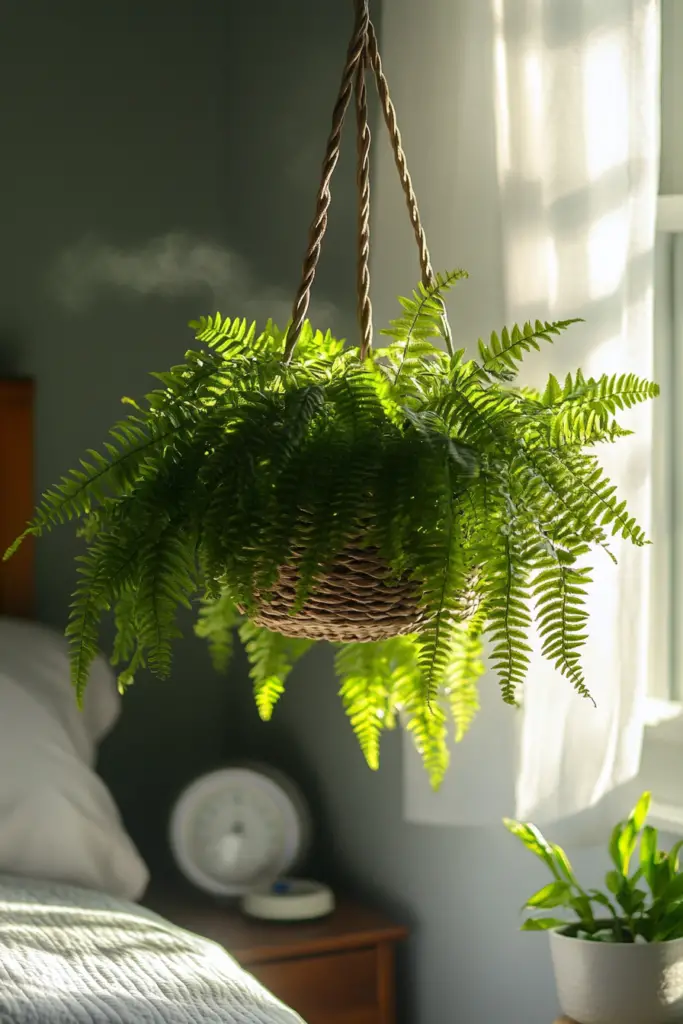
Plant 2: Bamboo Palm
Bamboo Palm, also known as Reed Palm, brings a tropical flair to your bedroom while purifying the air. This elegant plant stands out for its air-cleaning prowess and ability to regulate humidity.
Toxin removal properties:
Bamboo Palm effectively filters formaldehyde, benzene, and carbon monoxide from indoor air.
It ranks on fifth position according to NASA’s list of air-purifying plants.
This palm can remove up to 1,400 micrograms of formaldehyde per hour.
Humidity regulation:
Bamboo Palm naturally increases air moisture through transpiration.
It can boost humidity levels by up to 5%.
This feature makes it ideal for dry climates or homes with air conditioning.
Care tips and placement suggestions:
Place your Bamboo Palm in bright, indirect light for optimal growth.
Water it when the top inch of soil feels dry.
Mist the leaves occasionally to prevent spider mites.
Position the palm near an east or west-facing window, but away from direct sunlight.
A corner of your bedroom or near a reading nook works well for this plant.
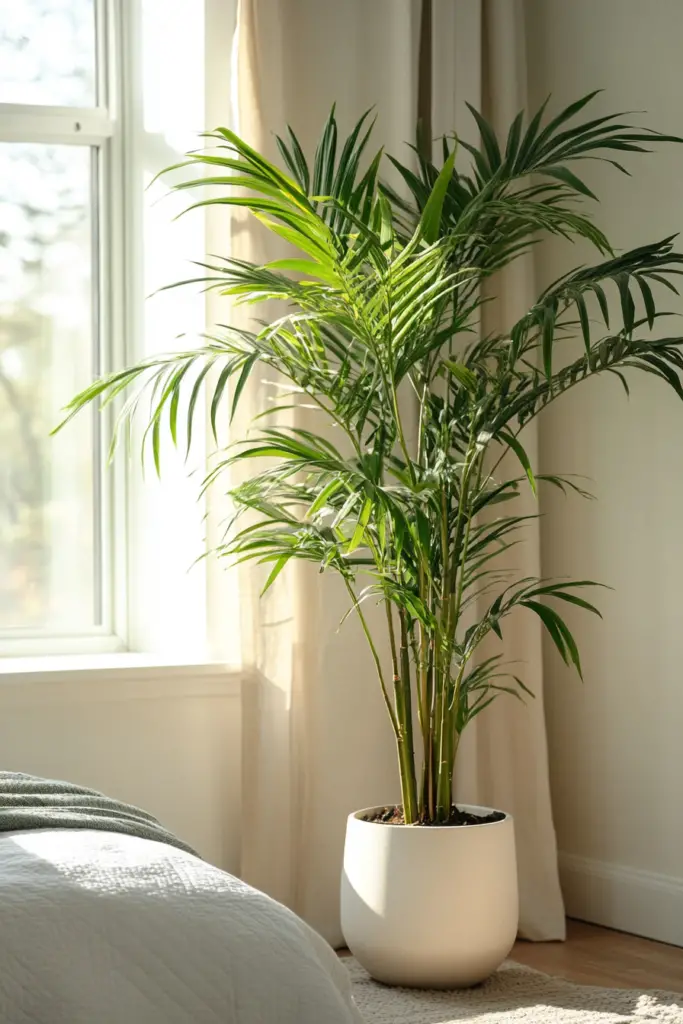
Plant 3: Gerbera Daisy
Gerbera Daisies bring a splash of color and significant health benefits to your bedroom.
These cheerful flowers offer more than just visual appeal, making them a smart choice for your sleep sanctuary.
Oxygen production during the night:
Gerbera Daisies continue to release oxygen at night, unlike many plants.
This nocturnal oxygen boost can improve sleep quality.
The increased oxygen levels may help reduce sleep apnea symptoms.
Mood-boosting qualities:
The vibrant colors of Gerbera Daisies can lift spirits and reduce stress.
Their presence may alleviate symptoms of seasonal affective disorder.
These flowers can create a more positive and energizing bedroom atmosphere.
Care requirements and bedroom placement ideas:
Place Gerbera Daisies in a spot with plenty of indirect sunlight.
Water them when the top inch of soil feels dry.
Remove spent blooms to encourage new flower growth.
Position the plant on a bedside table or dresser for a cheerful morning view.
Consider grouping different colored Gerberas for a striking visual impact.
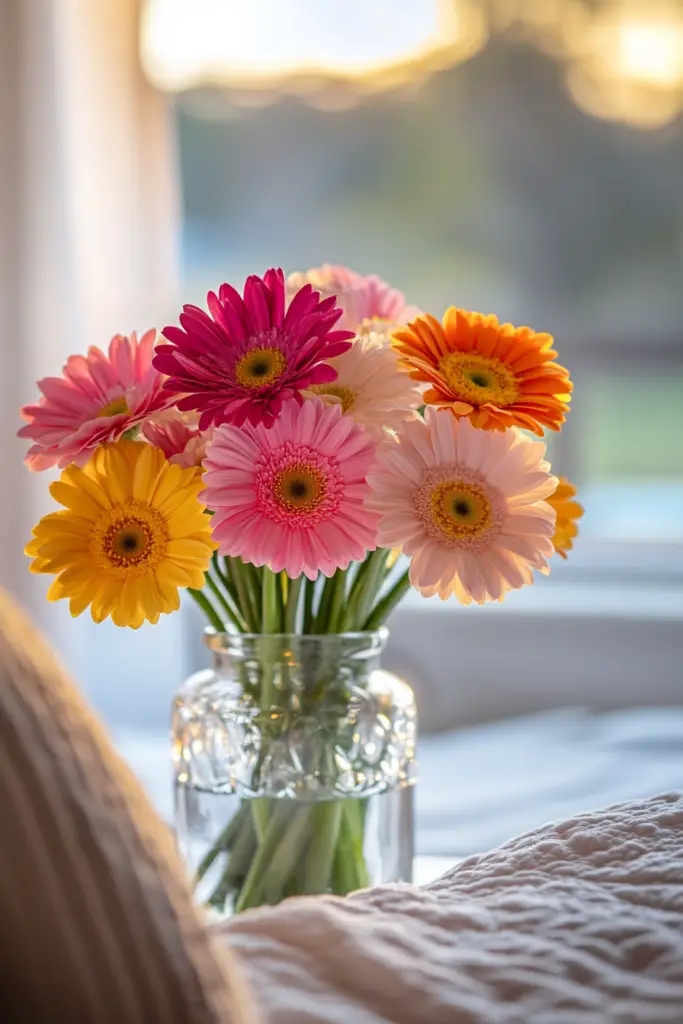
Plant 4: Golden Pothos
Golden Pothos, also known as Devil’s Ivy, is a versatile and hardy plant perfect for bedroom air purification.
Its cascading vines and heart-shaped leaves add a touch of nature to any sleeping space.
Versatile air purifier:
Golden Pothos excels at removing formaldehyde, benzene, and carbon monoxide from indoor air.
It can absorb and neutralize unpleasant odors, creating a fresher bedroom environment.
This plant continues to purify air even in low light conditions.
Stress-reducing properties:
The presence of Golden Pothos can lower stress levels and promote relaxation.
Its lush green foliage may improve mood and reduce anxiety.
Studies suggest that interacting with this plant can lower blood pressure.
Care guidelines and creative display options:
Golden Pothos thrives in various light conditions, from low to bright indirect light.
Water when the top inch of soil feels dry, and avoid overwatering.
Hang it in a decorative macramé planter for a bohemian look.
Train the vines along a bedroom wall or around a window frame for a natural green curtain effect.
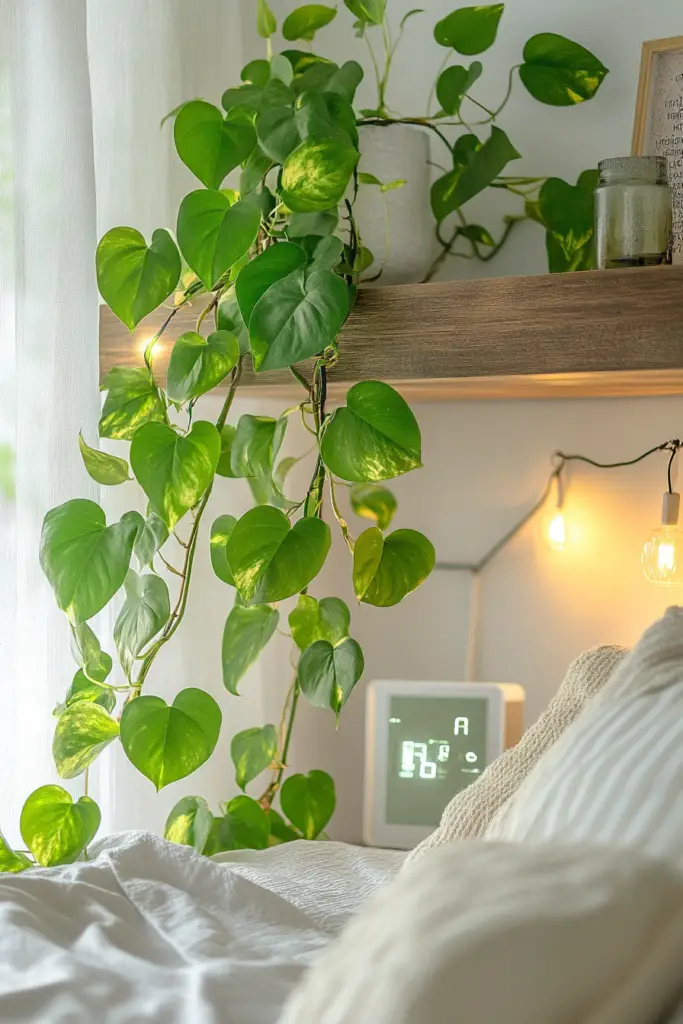
Plant 5: Rubber Plant
Rubber Plants, with their glossy leaves and striking appearance, offer both aesthetic appeal and health benefits.
These robust plants can significantly improve your bedroom’s air quality while requiring minimal care.
Formaldehyde removal:
Rubber Plants excel at removing formaldehyde from indoor air.
They can filter out other harmful volatile organic compounds (VOCs).
Their large leaves increase the plant’s air-purifying efficiency.
Low-maintenance benefits:
Rubber Plants thrive with minimal attention, making them ideal for busy individuals.
They’re resistant to most pests and diseases.
These plants can tolerate lower light conditions, perfect for bedrooms.
Care instructions and size considerations for bedrooms:
Place Rubber Plants in bright, indirect light for optimal growth.
Water when the top inch of soil feels dry, reducing frequency in winter.
Prune regularly to control size and maintain a compact shape for bedroom spaces.
Consider a dwarf variety if space is limited, or allow a full-sized plant to become a striking focal point.
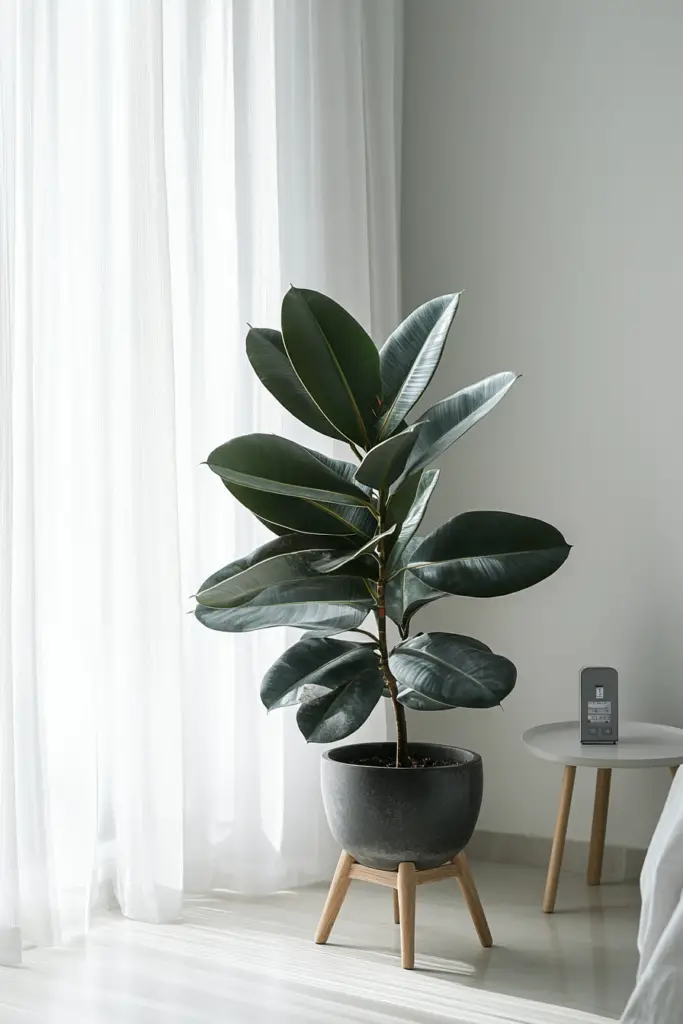
Maximizing the Benefits of Bedroom Plants
To fully harness the power of bedroom plants, strategic placement and care are crucial.
This section explores how to optimize your green allies for maximum health benefits.
1. Optimal number of plants per room:
NASA recommends one medium-sized plant per 100 square feet of space.
For average bedrooms, 2-3 plants suffice for air purification.
Larger rooms may benefit from 4-5 plants strategically placed.
2. Combining plants for synergistic effects:
Pair high oxygen-producing plants with toxin-removing varieties.
Combine humidity-boosting plants with those that excel in formaldehyde removal—group plants with similar care requirements for easier maintenance.
3. Maintenance tips for healthy plants and clean air:
Dust plant leaves weekly to maximize air purification efficiency.
Rotate plants quarterly to ensure even growth and light exposure.
Prune regularly to promote healthy growth and prevent overgrowth.
Replace potting soil annually to maintain nutrient levels and prevent mold growth.
Conclusion
Incorporating plants into your bedroom can significantly enhance your health and sleep quality.
Start small by adding one or two plants and observe the positive changes in your sleep environment.
With proper care and placement, these natural air purifiers can transform your sleep sanctuary into a rejuvenating oasis.
- 16 Funky Living Room Ideas to Bring Colors, Fun & Personality to Your Space - November 9, 2025
- 12 Small Bathroom Ideas on a Budget That Make Your Space Look Bigger & Stylish - November 6, 2025
- 20 Modern Boho Living Room Ideas That Are Cozy & Absolutely Stunning - November 2, 2025
